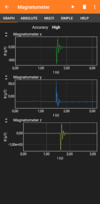Difference between revisions of "LC circuit"
(Created page with "{{Infobox Experiment | Name = RC circuit | Category = Magnetism | Sensors = magnetometer }} The magnetic sensor is used to display the magnetic field of a coil in a RC cir...") |
|||
| Line 19: | Line 19: | ||
==Introduction== | ==Introduction== | ||
| − | In this experiment a very simple LC circuit is created with a coil and a capacitor. To measure the magnetic field the coil has to have a low resistance and a high inductance. Such coils can be bought in audio supply and can be a bit expensive. | + | In this experiment a very simple LC circuit is created with a coil and a capacitor. To measure the magnetic field the coil has to have a low resistance and a high inductance. Such coils can be bought in audio supply and can be a bit expensive. The used coils for this experiment can be found at [https://www.hammfg.com/electronics/transformers/choke/195-196] and [https://www.monacor.de/produkte/components/lautsprechertechnik/frequenzweichen-und-bauteile-/lsi-100t/] |
==Examples== | ==Examples== | ||
Revision as of 09:27, 1 December 2022
| Experiment | RC circuit |
|---|---|
| Category | Magnetism |
| Used sensors | magnetometer |
The magnetic sensor is used to display the magnetic field of a coil in a RC circuit.
Contents
Requirements and experimental material
- smartphone (with phyphox-app and magnetic sensors)
- a coil with low resistance and high inductance (for more information see paper)
- some capacitors between 470uF and 22.000uF
- a battery or power supply
Introduction
In this experiment a very simple LC circuit is created with a coil and a capacitor. To measure the magnetic field the coil has to have a low resistance and a high inductance. Such coils can be bought in audio supply and can be a bit expensive. The used coils for this experiment can be found at [1] and [2]
Examples
TODO
Paper, and work sheets
The experiment was developed in a thesis for education students (Staatsexamensarbeit) at the University of Konstanz. The results where published in an open access paper [3], where a lot of additional information can be found.
Work sheets in German where developed and can be found here. TODO
